9 min read 🤓
Cover thyself ( * )
Petit tour de table, grande bouffe [iii]
july 08, 2009.
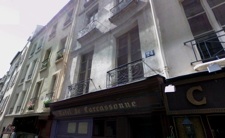 This is a picture
of the Hotel de Carcassonne in the rue Mouffetard in Paris. A couple of weeks ago I snapped it in Google's Streetview (click to enlarge).
I could have taken a metro or I could have hopped on my bike and go have a look for myself, but as Google's images of our cities are relatively recent,
Streetview is a pretty good way to check
whether something or other that used to be some years ago in a certain streetviewable spot is still there.
This is a picture
of the Hotel de Carcassonne in the rue Mouffetard in Paris. A couple of weeks ago I snapped it in Google's Streetview (click to enlarge).
I could have taken a metro or I could have hopped on my bike and go have a look for myself, but as Google's images of our cities are relatively recent,
Streetview is a pretty good way to check
whether something or other that used to be some years ago in a certain streetviewable spot is still there.
Some half a century ago there was already a Hotel Carcassonne at 24, rue Mouffetard in Paris. That was in the early 1960s, and
it is not unlikely that it was there long before.
[ Added 29 March 2013: ] Subsequent research showed that, even though there is still the sign reading 'Hotel de Carcassonne', there no longer is a hotel at 24, rue Mouffetard. You can read all about this in Re:Table, a booklet that accompanies our 2010 reconstruction of Spoerri's 1961 Carcassone table.
The drawing below shows a topographic layout of the table ( ** ) in room 13 of the hotel Carcassonne, as it was on october 17th, 1961, at 15h47.
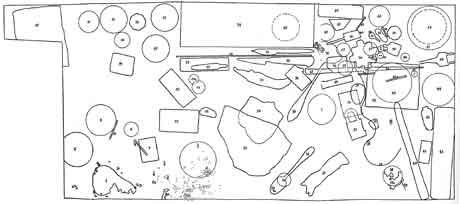
The image-map is from Daniel Spoerri's booklet Topographie Anecdotée du Hasard ("An anecdoted topography of chance") ( *** ). Spoerri at the time was living in room 13 of the Hotel Carcassone. The drawing (on scale) shows the outlines of (80) objects that that day were lying on his table. They are numbered, and the map is an index to the booklet. It invites the non-linear lecture of its 80 pieces of text, of varying length, in which the artist describes the objects along with memories and associations that they invoked.
I remember how thirty years ago I came to see Spoerri's drawing as a faithful picture of the universe. Besides being pretty funny at times, and an interesting document per se, his rigorous and meticulous description, as in a scientific report, of the chance constellation of the objects on the table as he found them at that particular time and day, struck me as a profound expression of the elusiveness of each of our individual lives, all of which transcend both each other and themselves. Even the smallest and apparently insignificant among a life's material manifestations branch out and relate to a myriad of past and future lives and events. Yes. It seems obvious that once taken to its logical conclusion, a full description of a random freeze, like the one Spoerri set out to execute, will be iso-form to a collective 'memory dump' of pretty much all of living mankind. For not a single one of a life's details exists in a void; and given whichever two seemingly unrelated facts in whatever two lives, these eventually will be found connected by at least one associative memory path - and therefore (that's unavoidable) by many different ones ....
While preparing this entry I was leafing through Spoerri's Topographie,
and read several of the descriptions linked to objects that were somehow
food and drink related. These made me think of the table
in my grandparents' living room.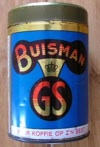 Which then in turn reminded me of the little blue metal tins of Buisman,
of which you see a picture here. The tins contained some sort of caramelized
sugar, which, with the use of a small and rather flat metal spoon that came
with the tin, one added to coffee before pooring on the boiling water, in
order to enhance the brew's taste. The - in Holland widespread, very Dutch
- custom of adding Buisman to coffee, has since, I guess, the 1980s more
or less disappeared. It must have been also in the 1980s that these little
blue tins last were on my mind. That is, until not so long ago, when Spoerri's
table made me think of them again.
Which then in turn reminded me of the little blue metal tins of Buisman,
of which you see a picture here. The tins contained some sort of caramelized
sugar, which, with the use of a small and rather flat metal spoon that came
with the tin, one added to coffee before pooring on the boiling water, in
order to enhance the brew's taste. The - in Holland widespread, very Dutch
- custom of adding Buisman to coffee, has since, I guess, the 1980s more
or less disappeared. It must have been also in the 1980s that these little
blue tins last were on my mind. That is, until not so long ago, when Spoerri's
table made me think of them again.
Thus every table - be it full or empty, whether a mess or neatly laid out - at any given moment in time
will reflect most of the describable universe.
(Any other odd object would do just as well.)
Which is a triviality as much as it is a mystery.
But as things go, tables do have that little something extra ...
The table is emblematic for - at the very least - our western society's history. It is an accessory that is at the heart of several of our culture's day-to-day rituals, and as such played a role in many of its key moments. Be it historical (just think of any odd treaty signed in the 20th century) or apocryphal (as in Christ's last supper or King Arthur's round table).
Human anatomy made the table, pivot of two of our favorite activities: eating and writing. Both are best and most comfortably done while sitting, using a horizontal support for food, paper or - more recently - a keyboard to be posed upon.
Homo sedens.
We are sitting. A seated species.
And tables are what we sit at.
For me personally, as probably for no few of our viewers, a life without tables is difficult to imagine. Whenever I get to a place that for a certain time (days, weeks, months, years) must be my home, the first thing I will do is set up 'my table'. If there is none present, the first thing I do is get me one. Or construct one. I indeed have been constructing tables, over and over again.
At any instant each of these will, by extrapolation, reflect all of our universe, beginning with the parts of it that are closest to the table's user/owner. When one contemplates someone's table, it's like peeping into the person's head ... By clicking to enlarge the following pictures you may peep into mine. The colored ones froze all that was the case on each of my 3 tables, just a couple of days ago, in France and the Netherlands. The black and white photograph did the same to my table in the Amsterdam Quellijnstraat almost thirty years ago, in june 1980. As you see, nothing much changed (but there is no longer a cat, neither here or there, as, over the years, I grew allergic to cats ...)
 |
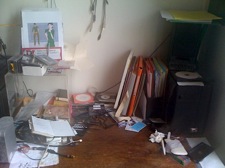 |
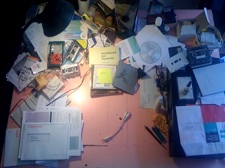 |
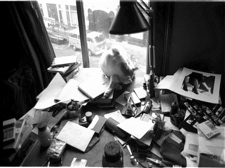 |
Armies of improvising electro-acoustic musicians, working with objects and small instruments, or with laptops, are comfortable using the floor to spread out and manipulate the sound producers they use, while being cross-legged, half hanging or lying among them. But not me. I very much prefer to have them laid out before me on a table. That is why already early on I came to think of my practice as "tafelmuziek". Table music. Which then became the title of the ookoi's first CD: "Tafelmuziek/Muziektafel (2004)".
With Jean-Jacques Duerinckx such reflections led us to chose "A Table!" as a theme to guide us in a series of duo-performances. Whereas English speakers will see a noun followed by an exclamation mark, French speakers know that same expression as the yell that in french households summons family members to interrupt whatever other activity they are engaged in, and come and sit down à table, for one of the daily meals.
Each of the different tables that in different places we stumble upon ("A table!") we want to be like the Wishing Table in the Brother Grimm's household tale: we 'ask' it to 'cover itself' with the objects and things that over time we gather, use, discard or keep and - as much as possible - collect locally, at or near the venues where we come to perform. Some of these will be used to make sounds, some of them won't.
The following are photographs of the tables we sat at during our 'little table tour', in the weeks following the Brass residency.
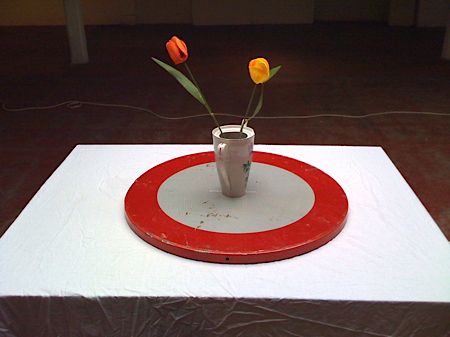 |
A traffic sign just like the one in the picture lay discarded somewhere along the highway between Braine-l'Alleud (Eigenbrakel) and Brussels. We passed it in JJ's car when we were on our way to play at l'Ecurie in Brussels, on sunday march 29th. It was not possible to stop to pick that one up, but as I liked the idea of that sign in the middle of our table, I kept an eye open. We indeed then found another one, somewhere in Brussels, not far from l'Ecurie ...
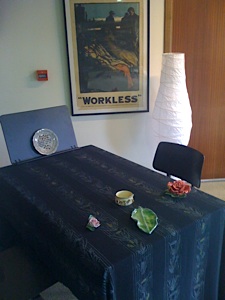 |
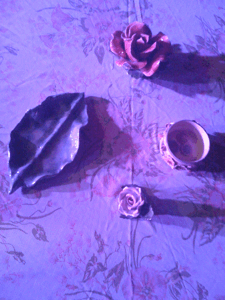 |
Thanks to an assortment pottery that was left at the Place du Jeu de Balle, our next two tables - in the Brussels Café Dada on may 6th (right) and in the Cultureel Centrum Oratoriënhof in Louvain (Belgium) on may 7th (left) - had a strong post-funeral touch. (The little plate on the music stand at the back end of the Louvain table reads: "Le passé comme l'avenir c'est du présent qui se déplace". If you look closely you can spot it also in one of the pictures of my tables above.)
After the Louvain adventure, a savage nightly ride through flemish inlands
was followed by a short nap in the Hotel Afrit 28 in Heusden-Zolder,
where early morning we enjoyed a Belgian breakfast animated by large-screen
lip-synced american tele-commercials full of fat burn and meat cuts (thank you
Timo and Metaphon,
for all of it has been the greatest pleasure!), we arrived in the Artspace Rondeel
in Maastricht (the Netherlands).
There, as a consequence, funereal symbolism gave way to sort
of a neo-colonial scenery.
More than merely logical, it felt merely appropriate.
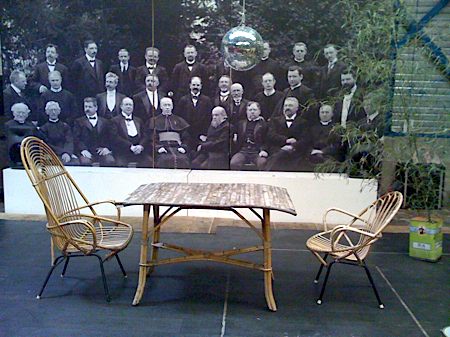 |
[ Click the picture to view "Missie :: Broeders", a short uTube extract of our performance at the Maastricht ArtSpace. ]
[ previous A Table!-entry: A Table au Brass (sketches) ]
SoundBlog entries related to our 2010 reconstruction of Daniel Spoerri's Carcassone table:
(june 06, 2013) - A Carcassonne Yodel in Blue [Kunsttour 2013]
(december 24, 2011) - Touching Base
(april 19, 2011) - (Topographic [Table) Topographique]
(september 26, 2010) - Bonjour Schiphorst! Farewell Blue Vase! [and then i joined the avantgarde {iii}]
(august 10, 2010) - Shake your booty (on the workfloor) [and then i joined the avantgarde {ii}]
(july 18, 2010) - From (h)ear to avantgarde
(june 10, 2010) - A kitchen table and a game of cards [KT2010, ii]
(june 04, 2010) - Table archaeology: unearthing the picture trap
(may 18, 2010) - Instant coffee and (b)[re](a)d wine (the Spoerri re:Table in Extrapool, Nijmegen)
(may 13, 2010) - attention! oeuvre d atable
(july 08, 2009) - Cover thyself ( * ) Petit tour de table, grande bouffe [iii]
notes __ ::
(*) "... he took his little table of his back, set it down before him, and said,
'Cover thyself,' and then everything appeared that his heart desired." (from: 'The Wishing-Table, the Gold-Ass,
and the Cudgel in the Sack' - Brothers Grimm, 'Household Tales'.)
[ ^
]
(**) "A table is an item of furniture comprising a surface supported by a base or legs. It may be used to hold articles such as food at a convenient or
comfortable height when sitting, and is therefore often used in conjunction with chairs [...] A table specifically intended for writing and office work
is a desk [...]" - (Wikipedia
/ july 6th, 2009)
[ ^
]
(***) I first read Spoerri's Topographie in
1981 or 1982, in a Dutch translation by Jean Schalekamp (Geanekdoteerde
topografie van het toeval), which was published in edition 7 of the
literary magazine Randstad,
from 1964 (De Bezige Bij). Later in Paris, in 1991 or 1992,
I got the facsimile reedit of the 1962 original, published by the Centre
Pompidou in 1990. [ ^ ]
tags: A Table!, Daniel Spoerri, chance
# .318.
Read more about Artspace Rondeel Maastricht (ARM) on the SoundBlog:
(june 28, 2011) - the end of an arm, the end of an era
(may 30, 2010) - Auto*noom
en un*titled
(february 24, 2010) - "Zonder
Vreesch, want immer Dapper, gaan wij des Zondags naar den Kapper..."
(november 11, 2009) - Waiting
in the Wings, often
(july 09, 2009)- Cover
thyself
(june 01, 2009) - Playing
The Popular Classics
(april 01, 2009) - A
Block with a Name
(june 06, 2008) - Raudio
Graffiti: almost live !
comments for Cover thyself ::
|
Comments are disabled |